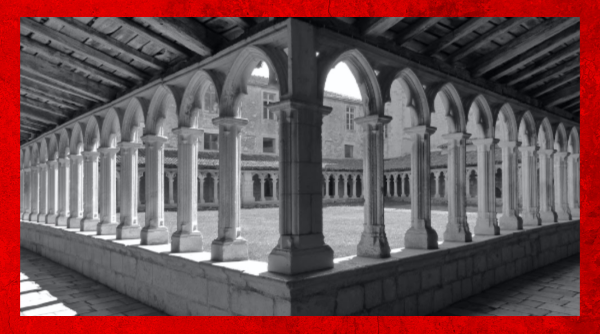This Present Paradise: A Series of Reflections on St. Elizabeth of the Trinity
(Start with part 1 here.)
My friend Katherine and I walked hesitantly up to the door, on which hung a sign inviting visitors into the small lobby of the cloistered Carmelite convent in Alhambra, California. We slipped into the quiet and waited, glancing curiously about the simple interior. In front of us was a stairway, to our left a small parlor with a screen to separate nuns from visitors, and to our right a closed door. After a moment of silence and uncertainty, Katherine nudged me and pointed to a small opening in the wall opposite us.
A tiny window began to turn with a soft grating sound. We heard a barely audible whisper and crept towards it. “Hello…….” it sounded like a voice from another world, a breeze from Mt. Horeb which required absolute stillness to hear. “Can…I..help…you?”
We bent over the screen and explained that we were about to begin a retreat for women the following day and would be grateful for the community’s prayers for all involved. We were assured in hushed tones that the nuns would be praying for us.
I had a sudden inspiration. “May we stay and pray here awhile?” I asked, imaging us kneeling right there in the lobby.
“Would you like to pray in our chapel?” The muffled voice asked. We looked at each other.
Chapel?
To our right, the sound of a buzzer and a door unlocking…we pushed it open, and entered a beautiful sanctuary full of filtered light and a hundred years of prayer. I could see the screens behind the altar where the nuns prayed. As we knelt, I honestly felt that I was somewhere utterly timeless and yet completely rooted.
What tradition were we tiptoeing into? It was the same centuries-old spiritual space occupied by St. Elizabeth of the Trinity and the thousands like her who had chosen a life of hiddenness and obscurity and openness to grace. It was an inheritance of silence and solitude and perpetual prayer, of praise and reparation and intercession behind walls and screens and grilles. Not to be a prison, but rather a sanctuary. “The grating in a Carmelite monastery is not to keep the sisters in,” said Archbishop Fulton Sheen, “But to keep the world out.” (Wit and Wisdom page 200)
The grating in a Carmelite monastery is not to keep the sisters in, but to keep the world out.
-Archbishop Fulton Sheen
The first ‘Carmelites’ were pilgrims or crusaders who stayed in the Holy Land and lived hidden away in little cells on Mt. Carmel, like the Prophet Elijah, their spiritual father. Their austere rule was written by St. Albert, the patriarch of Jerusalem, in the early 1200s. When the Holy Land fell to the Muslims and became unsafe, the early monks left to set up monasteries around Europe. The Carmelites became one of the four great mendicant orders, meaning that the intentional personal and communal poverty of the order necessitated begging for basic needs.
The first community of nuns was founded in that penitential spirit of poverty in 1452. But just over a hundred years later, St. Teresa of Avila began to realize, in the midst of her own deeper conversion, that the order had fallen away from the strictness of its founding charism. She wanted to do away with visitors in the convents, frivolous conversations, nuns owning personal property, and other distractions and abuses. Together with St. John of the Cross, she began a reform to bring back its foundational sacred simplicity, and the Discalced (“shoeless,” in reference to the sandals they wore) Carmelites were born.
The Convent in Dijon, into which Elizabeth Catez had happily disappeared to become Sr. Elizabeth of the Trinity, was a Discalced Carmelite convent founded in 1605, about twenty years after the death of St. Teresa of Avila. The nuns in Dijon fully embraced the deep spirit of prayer of their foundress, and it was that life of asceticism and self-giving that enchanted Elizabeth. It was a perfect place for her to bloom—a flower in the arid but beautiful desert of Carmel.
There she would live fully a life of liturgical prayer, days and weeks and years regulated by the rhythm of the Church itself and making them one with the those in heaven. When writing about their celebration of the Immaculate Conception in 1904, Elizabeth confided, “It was like an echo of the heavenly feast.” (Letter 216) The Liturgy of the Hours was like the pulse of their community, it was the prayer of the Church, offered in regular intervals like the heavy, solid, immovable beads between decades of personal prayer, communal meals, and the discipline of daily work.
In a letter Elizabeth describes her day: “We begin our day with an hour of prayer at 5 o’clock in the morning, then we spend another hour in choir to say the Divine Office…then Mass. At 2 P.M. we have Vespers, at 5 P.M. prayer until 6 P.M. At 7:45, Compline. Then we pray until Matins, which is said at 9 P.M., and it is only around 11 P.M. that we leave the choir to go to take our rest. During the day we have two hours of recreation; then, after that, silence the whole time. When I am not sweeping, I work in our little cell.” (letter 168) Elizabeth, at the time of this letter, was a “habit sister” who assisted with mending the nuns’ habits during work hours.
Such a regulated life but so desired by our saint—she saw that by burying herself without distraction into prayer and into the Church’s deepest vocation: love itself, she was becoming totally available to not only God but the entire world. The apparent limitations and exactness of the rule existed so that she could conquer herself, or rather, maybe, be conquered by Christ, and therefore be empty and ready to serve. So in the end, the rule gives absolute freedom and complete peace.
“How freeing it is!” wrote my friends the Poor Clares about their rule, or ‘horarium’ as they call it. “How it offers stable support so as not to squander time and turn in on ourselves. It provides structure to our day that naturally lends itself to prayer, healthy habits, creative outlets, and authentically human (life-giving) experience/encounters (like consistently sharing meals and meaningful conversation), enjoying both communal (familial) and personal (quiet) times of recreation.”
My friend Christina has given the Church her oldest daughter as a Dominican novice. As difficult as the separation and surrender is, Christina shared with me something her Annie (now Sister Catherine Paul) said in a moment of insight and profound truth as she prepared to leave: “I’ll never have to wonder if I’m doing the will of God again.” Suddenly, in that light, the humility of obedience and the docility to the rule of an order become so clearly and totally releasing. Within it, what appears to be rigid and constraining—whether it be the rule or the will of the superiors—actually sets one completely at liberty to serve without wasting a moment wondering what that service should look like. The contemplative nun rises in the morning to pray and work and obey and die a little more to herself, to offer herself for the Church with all the missionary zeal of the apostles and martyrs and in total union with them. And not one moment or ounce of her strength is wasted or dissipated.
“From what troubles we are saved, my God, by the vow of obedience! The simple religious, guided by the will of her superiors alone, has the joy of being sure that she is on the right path; even when she is sure that her Superiors are mistaken, she need not fear.” – St. Therese of Lisieux, Story of a Soul
For me, who sometimes wanders around wondering what in the world I should do next, overwhelmed by the sheer volume of choices and the crush of daily responsibilities, this breathes a certain appeal. And so, while I don’t have superiors (save the mutual surrender in marriage), I too have a simple—a very simple—rule to guide my days. Basic prayer, family needs and obligations, set time for work and even a bit of reading pencilled in. Knowing that there’s a time for everything so that the One Thing is never neglected and each next right thing—whether it is a hungry child or a messy kitchen—can have my full attention.
It doesn’t just save my sanity. It just may save my soul.
St. Elizabeth would agree. “…from morning to evening the rule is there to express the will of God, moment by moment. If you knew how I love this Rule, which is the way He wants me to become holy…” (letter 168, emphasis mine.)
That’s what it is, I thought while kneeling in that Carmelite chapel in California, breathing in air which was mingled with incense and sanctity. That ‘something’ which is firmly grounded in the now and yet seems to surpass it somehow. It is simply this: holiness.
Image courtesy of Unsplash.
Editor’s note: This article originally appeared on SpiritualDirection.com and is reprinted here with kind permission.













